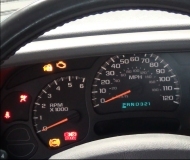Sounds like you recently disconnected the battery or let it run dead. Failure to stay running is a real common result. The engine computer has to rebuild everything it had in memory. Most of that occurs without you even noticing, except for "minimum throttle". Until that is relearned, the computer won't know when it must be in control of idle speed. The engine may not even start unless the accelerator pedal is held down 1/4". It will tend to stall at stop signs, and you won't get the nice idle flare-up to 1500 rpm at start-up.
The repair procedure is real involved. Drive at highway speed with the engine warmed up, then coast for at least seven seconds without touching the pedals. That is it.
The MAP sensor measures intake manifold vacuum. That is a factor of engine load. Chrysler is the only manufacturer that has never needed a mass air flow sensor to make their engines run right. Those measure the weight of the incoming air, then the computer calculates the correct amount of fuel to go with it. All the other manufacturers use the MAP sensor to measure barometric pressure, and usually as a back-up strategy when the MAF sensor fails.
MAP sensors are sensitive enough to use to measure engine speed by detecting the very slight increase in vacuum each time a cylinder takes a gulp of air. We do not actually do that, but we could. The original sensors used a piezo-electric crystal, the same thing in a ceramic phonograph cartridge. Applying pressure to a crystal causes it to generate a tiny voltage. Circuitry in the sensor amplifies it to produce the signal voltage. Constant over-filling the gas tank caused fumes to migrate up to the sensor and deteriorate the protective gel, then destroy the sensing element. The clue to a failed sensor was you could keep the engine running, (poorly), if you kept moving the accelerator pedal. Speed or direction did not matter; it just had to be moving.
Later, redesigned sensors use a "strain gauge". That is a very fine, long wire wrapped around a plastic core. Vacuum pulls on a diaphragm that tugs on the wire. Stretching the wire makes it longer and thinner, both of which increase its resistance. The resistance changes are converted to the signal voltage.
These sensors are fed with 5.0 volts and ground. The acceptable range of signal voltage is approximately 0.5 volts to 4.5 volts. Any voltage outside that range will set a diagnostic fault code, "voltage too high" or "voltage too low". When the ignition switch is turned on, the signal voltage will typically be around 4.2 to 4.4 volts. That represents barometric pressure, and is put in memory for that drive cycle. Once the engine starts running, the drop in pressure, (vacuum), results in a signal voltage of around 1.2 volts to maybe 1.5 volts. The exact value is unimportant. The computer will figure out when there is a problem. It can set a fault code for "no change in MAP from start to run", if the vacuum hose is disconnected. It can also set a "MAP pneumatic fault" when the signal voltage does vary but not fast enough. That would be typical of a crushed vacuum hose or with some other restriction that makes vacuum changes show up inside the sensor too slowly. That relates to them being sensitive enough to measure each cylinder's intake pulse.
Since the mid 1990's, Chrysler bolts the MAP sensors right to the throttle body so no vacuum hose is used. That eliminates the possibility of a leaking or restricted hose. The MAP sensor has the biggest say in fuel metering calculations. It sets the starting point, then the computer fine tunes those calculations based on the readings from the other sensors. No temperature sensor can cause a crank/no-start condition. Even the throttle position sensor contributes very little to the fuel calculations. The front oxygen sensors tell the computer that what it wanted to make happen actually happened. The rear oxygen sensors just watch to make sure the catalytic converters are doing their job of cleaning up the exhaust gas.
SPONSORED LINKS
Sunday, October 1st, 2017 AT 8:45 PM





